Related Research Articles

Centaurus A is a galaxy in the constellation of Centaurus. It was discovered in 1826 by Scottish astronomer James Dunlop from his home in Parramatta, in New South Wales, Australia. There is considerable debate in the literature regarding the galaxy's fundamental properties such as its Hubble type and distance. NGC 5128 is one of the closest radio galaxies to Earth, so its active galactic nucleus has been extensively studied by professional astronomers. The galaxy is also the fifth-brightest in the sky, making it an ideal amateur astronomy target. It is only visible from the southern hemisphere and low northern latitudes.

Messier 81 (also known as NGC 3031 or Bode's Galaxy) is a grand design spiral galaxy about 12 million light-years away in the constellation Ursa Major. It has a D25 isophotal diameter of 29.44 kiloparsecs (96,000 light-years). Because of its relative proximity to the Milky Way galaxy, large size, and active galactic nucleus (which harbors a 70 million M☉ supermassive black hole), Messier 81 has been studied extensively by professional astronomers. The galaxy's large size and relatively high brightness also makes it a popular target for amateur astronomers. In late February 2022, astronomers reported that M81 may be the source of FRB 20200120E, a repeating fast radio burst.
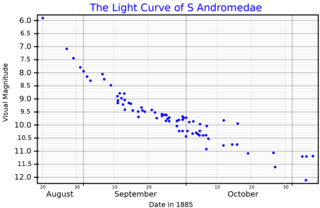
SN 1885A was a supernova in the Andromeda Galaxy, the only one seen in that galaxy so far by astronomers. It was the first supernova ever seen outside the Milky Way, though it was not appreciated at the time how far away it was. It is also known as "Supernova 1885".
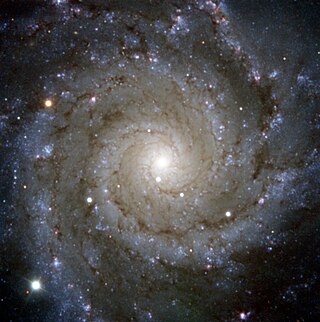
Messier 74 is a large spiral galaxy in the equatorial constellation Pisces. It is about 32 million light-years away from Earth. The galaxy contains two clearly defined spiral arms and is therefore used as an archetypal example of a grand design spiral galaxy. The galaxy's low surface brightness makes it the most difficult Messier object for amateur astronomers to observe. Its relatively large angular size and the galaxy's face-on orientation make it an ideal object for professional astronomers who want to study spiral arm structure and spiral density waves. It is estimated that M74 hosts about 100 billion stars.

NGC 3982, also known as UGC 6918, is an intermediate spiral galaxy approximately 68 million light-years away in the constellation Ursa Major. It was discovered by William Herschel on April 14, 1789, and misclassified as a planetary nebula. NGC 3982 is a part of the M109 Group.

NGC 1559 is a barred spiral galaxy in the constellation Reticulum. It is also a Seyfert galaxy. Although it was originally thought to be a member of the Dorado Group, subsequent observations have shown that it is in fact not a member of any galaxy group or cluster and does not have any nearby companions. NGC 1559 has massive spiral arms and strong star formation. It contains a small bar which is oriented nearly east-west and spans 40″. Its bar and disc are the source of very strong radio emissions.

The Katzman Automatic Imaging Telescope (KAIT) is an automated telescope used in the search for supernovae.
Robert Owen Evans, OAM was a minister of the Uniting Church in Hazelbrook, New South Wales and an amateur astronomer who holds the record for visual discoveries of supernovae (42).
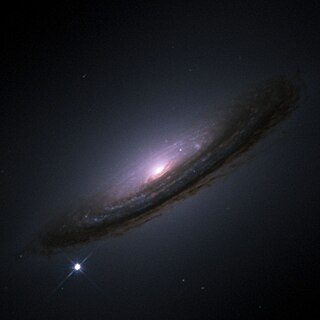
SN 1994D was a Type Ia supernova event in the outskirts of galaxy NGC 4526. It was offset by 9.0″ west and 7.8″ south of the galaxy center and positioned near a prominent dust lane. It was caused by the explosion of a white dwarf star composed of carbon and oxygen. This event was discovered on March 7, 1994 by R. R. Treffers and associates using the automated 30-inch telescope at Leuschner Observatory. It reached peak visual brightness two weeks later on March 22. Modelling of the light curve indicates the explosion would have been visible around March 3-4. A possible detection of helium in the spectrum was made by W. P. S. Meikle and associates in 1996. A mass of 0.014 to 0.03 M☉ in helium would be needed to produce this feature.

The known history of supernova observation goes back to 1006 AD. All earlier proposals for supernova observations are speculations with many alternatives.

Puckett Observatory is a private astronomical observatory located in the state of Georgia. It is owned and operated by Tim Puckett. Its primary observation goals are the study of comets and the discovery of supernovae. To facilitate the latter goal it sponsors the Puckett Observatory World Supernova Search whose astronomers have discovered 369 supernovae.
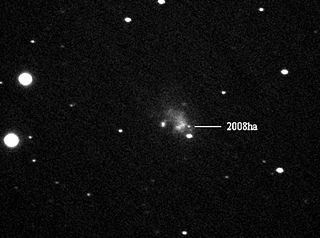
SN 2008ha was a type Ia supernova which was first observed around November 7, 2008 in the galaxy UGC 12682, which lies in the constellation Pegasus at a distance of about 21.3 megaparsecs (69 Mly) from Earth.

SN 1994I is a Type Ic supernova discovered on April 2, 1994 in the Whirlpool Galaxy by amateur astronomers Tim Puckett and Jerry Armstrong of the Atlanta Astronomy Club. Type Ic supernova are a rare type of supernova that result from the explosion of a very massive star that has shed its outer layers of hydrogen and helium. The explosion results in a highly luminous burst of radiation that then dims over the course of weeks or months. SN 1994I was a relatively nearby supernova, and provided an important addition to the then small collection of known Type Ic supernova. Very early images were captured of SN 1994I, as two high school students in Oil City, Pennsylvania serendipitously took images of the Whirlpool Galaxy using the 30-inch telescope at Leuschner Observatory on March 31, 1994, which included SN 1994I just after it began to brighten.

NGC 4666 is a spiral galaxy in the equatorial constellation of Virgo, located at a distance of approximately 55 megalight-years from the Milky Way. It was discovered by the German-born astronomer William Herschel on February 22, 1784. It is a member of the Virgo II Groups, a series of galaxies and galaxy clusters strung out from the southern edge of the Virgo Supercluster. John L. E. Dreyer described it as "bright, very large, much extended 45°±, pretty suddenly brighter middle". It is a member of an interacting system with NGC 4668 and a dwarf galaxy, and belongs to a small group that also includes NGC 4632.
SN 2011dh was a supernova in the Whirlpool Galaxy (M51). It was discovered on 31 May 2011, with an apparent magnitude 13.5. and confirmed by several sources, including the Palomar Transient Factory. A candidate progenitor was detected in Hubble Space Telescope images. The progenitor may have been a highly luminous yellow supergiant with an initial mass of 18-24 solar masses. The supernova peaked near apparent magnitude 12.1 on 19 June 2011. Emission spectra indicated that the explosion was a type II supernova, in which a massive star collapses once nuclear fusion has ceased in its core.
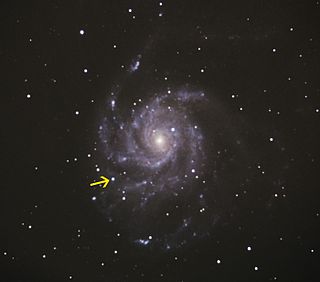
SN 2011fe, initially designated PTF 11kly, was a Type Ia supernova discovered by the Palomar Transient Factory (PTF) survey on 24 August 2011 during an automated review of images of the Messier 101 from the nights of 22 and 23 August 2011. It was located in Messier 101, the Pinwheel Galaxy, 21 million light years from Earth. It was observed by the PTF survey very near the beginning of its supernova event, when it was approximately 1 million times too dim to be visible to the naked eye. It is the youngest type Ia ever discovered. About 13 September 2011, it reached its maximum brightness of apparent magnitude +9.9 which equals an absolute magnitude of about -19, equal to 2.5 billion Suns. At +10 apparent magnitude around 5 September, SN 2011fe was visible in small telescopes. As of 30 September the supernova was at +11 apparent magnitude in the early evening sky after sunset above the northwest horizon. It had dropped to +13.7 as of 26 November 2011.

NGC 3938 is an unbarred spiral galaxy in the Ursa Major constellation. It was discovered on 6 February 1788 by William Herschel. It is one of the brightest spiral galaxies in the Ursa Major South galaxy group and is roughly 67,000 light years in diameter. It is approximately 43 million light years away from Earth. NGC 3938 is classified as type Sc under the Hubble sequence, a loosely wound spiral galaxy with a smaller and dimmer bulge. The spiral arms of the galaxy contain many areas of ionized atomic hydrogen gas, more so towards the center.

NGC 613 is a barred spiral galaxy located 67 million light years away in the southern constellation of Sculptor. This galaxy was discovered in 1798 by German-English astronomer William Herschel, then re-discovered and catalogued by Scottish astronomer James Dunlop. It was first photographed in 1912, which revealed the spiral form of the nebula. During the twentieth century, radio telescope observations showed that a linear feature in the nucleus was a relatively strong source of radio emission.

SN 2014J was a type-Ia supernova in Messier 82 discovered in mid-January 2014. It was the closest type-Ia supernova discovered for 42 years, and no subsequent supernova has been closer as of 2023. The supernova was discovered by chance during an undergraduate teaching session at the University of London Observatory. It peaked on 31 January 2014, reaching an apparent magnitude of 10.5. SN 2014J was the subject of an intense observing campaign by professional astronomers and was bright enough to be seen by amateur astronomers.
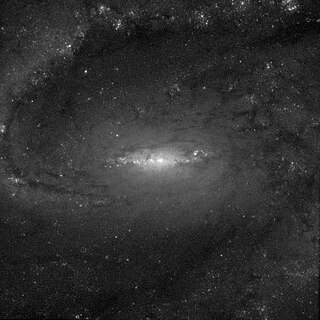
NGC 1255 is a barred spiral galaxy approximately 69 million light-years away from Earth in the constellation of Fornax.
References
- ↑ "March 2007 | Astronomy.com". Astronomy.com. Retrieved 2016-01-18.
- ↑ "Join the Great Supernova Race - Sky & Telescope". Sky & Telescope. Retrieved 2016-01-18.